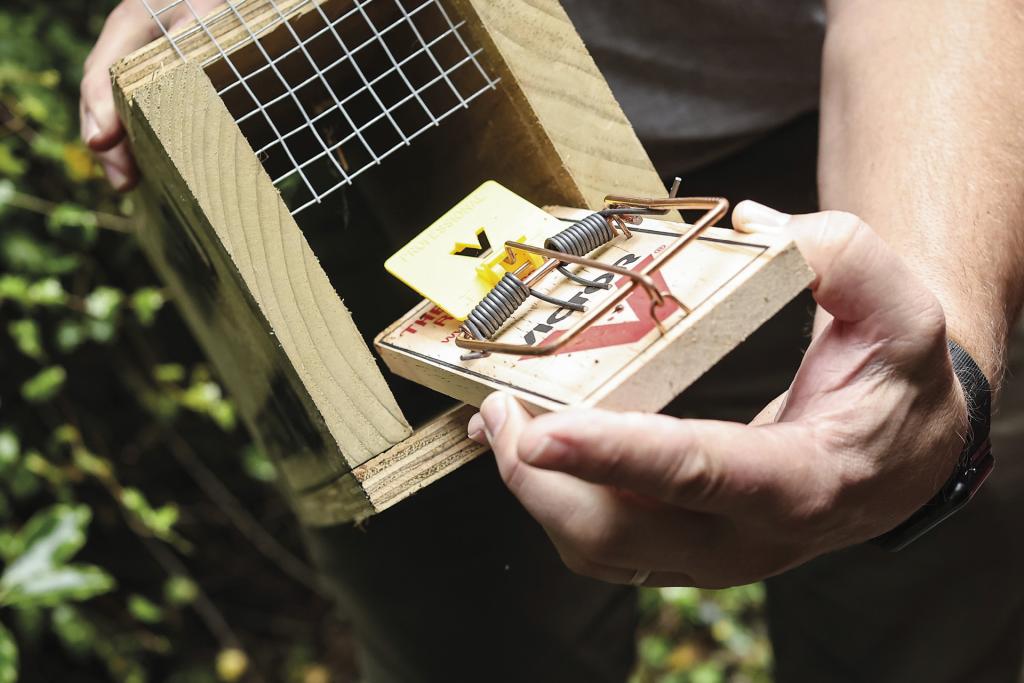Predator Free Timaru takes possession of AI cameras in fight to bring back native birds
PICTURED: Predator Free Timaru members Alice Brice, left, and Tim Exton, centre left, receive AI cameras from Rotary Club of Timaru members Lynette, centre right, and Lionel Wilson at the Scenic Reserve. (Photo: John Bisset / Stuff Limited).
The Rotary Club of Timaru has boosted local conservation efforts with the donation of six high-tech AI cameras to help Predator Free Timaru track and eradicate invasive species threatening native birdlife.
WORDS: Rachael Comer. The Timaru Herald.
Members of a group working to bring native birds back to Timaru, NZ, now have more tools under their belt, with a donation of AI cameras to detect and identify invading predators.
On 26 June, the Rotary Club of Timaru handed over six cameras and batteries, worth more than $10,000, to Predator Free Timaru to help in its eradication of possums, stoats, rats and hedgehogs from green areas such as the Scenic Reserve and the Highfield Golf Course.
The group has a trapping plan for the town to reduce the number of predators, with the land bordering the Scenic Reserve chosen to launch the campaign in February.
Predator Free Timaru member and DOC predator free ranger Tim Exton said the group was excited about the donation, which means there are now nine AI cameras in the district helping in the fight to protect native wildlife.
The other three cameras belong to the Ōrarī River Protection Group.
Tim said the cameras will help on several levels.
One, they will be able to record bird sounds and two, at night, the thermal side of it will identify anything that walks in front of it.”
He said the aim of the cameras is to help determine what predators are in the area.
“There’s no use trying to trap things if we don’t know what’s out there. These are going to take a lot of work off us. These cameras will arm us with information. It’s very exciting to receive them.”
The cameras will be spread around the district and provide an opportunity to do some species population counts.
Tim was grateful for the help of Shaun Ryan, of The Caophony Project, for his help with obtaining the cameras. He said the Predator Free group had taken five years to form since its inception and, with the donation of the cameras, things had really “stepped up”.

PICTURED: Traps have been given to residents living alongside Timaru’s Scenic Reserve in a bid to encourage more birdlife in town. (Photo: Aiman Amerul Muner / Stuff Limited).
The Rotary District 9999 Weekend of Connection in February took on the challenge of painting fences at the Timaru Botanic Gardens and assembling around 120 predator traps at the South Canterbury Eco Centre.
Tim had previously spoken to club members about the cameras, and club secretary Lionel Wilson said he would look into available funding for them.
“He did all the hard work,” Tim said.
Lionel had seen an advertisement for Air NZ funding for environmental projects and, hearing how expensive the cameras were, he asked Tim if he would mind Rotary applying for a grant on the group’s behalf.
The Air NZ Every Corner Project received more than 640 applications, with $1.2 million of funding to help bring more than 100 projects to life. The Rotary Club of Timaru received just over $10,000 for the project.
“We thank Air NZ wholeheartedly,” Lionel said.
Because of the cameras we will have a better idea of what [traps] to have and what is likely to be in them. Without Air NZ, we would still be wondering what predators we have.”
Through the work of the Predator Free group, people will one day hear the birdsong of natives in the area.
“The ultimate success is when we can see tūī or bellbird every day,” Lionel said.
Related news
International Bee Rotary Fellowship
Buzzing with purpose, Rotarians unite globally through the International Bee Rotary Fellowship.
Wetland Warriors: Leading the way in conservation and education
Wetland warriors restore habitats and inspire young minds through hands-on conservation and education.
Pitch for Purpose program an environmental success
Providing students with a platform to find innovative solutions to environmental concerns.
Join our newsletter for the latest updates
"*" indicates required fields

